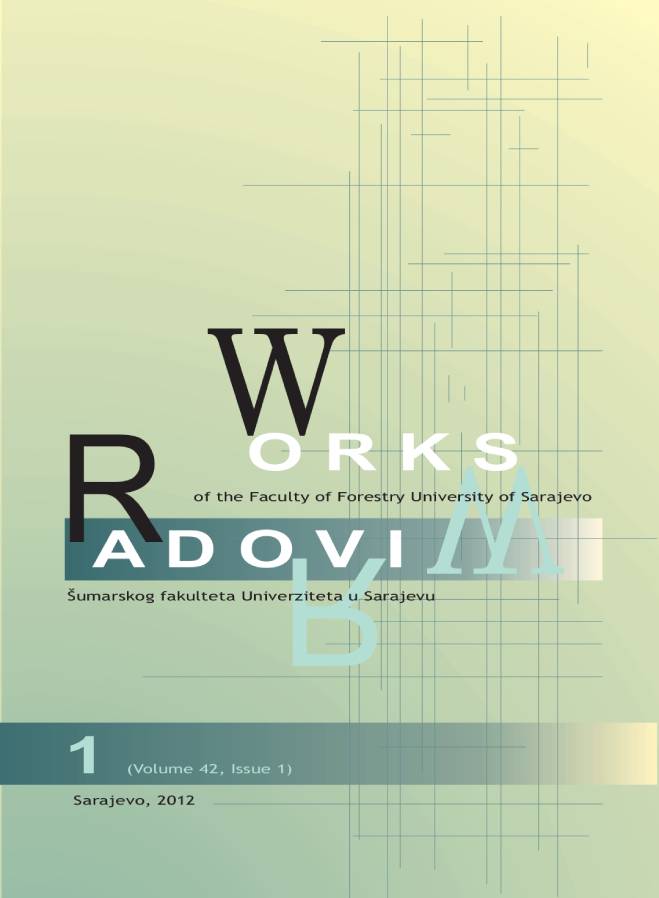PRESENCE OF MISTLETOE (Viscum album L.) ON URBAN TREES OF SARAJEVO
DOI:
https://doi.org/10.54652/rsf.2012.v42.i1.126Keywords:
mistletoe, hosts of semi-parasitic species, intensity of infection, health conditionAbstract
UDK 582.728.4:630*27(497.6 Sarajevo)
This paper has identified the presence of mistletoe (Viscum album ssp. album) on the trees in the urban part of Sarajevo. The mistletoe is a semi-parasitic flowering plant, which grows on a large number of hosts. In general, mistletoes are specialized species, which parasite only on particular trees and shrub species. They cause the dying of different forest species and the decorative trees. As for the forests in Bosnia and Herzegovina, the most important is mistletoe on fir (V. album ssp. abietis), while in terms of fruit trees and trees in urban areas, the mistletoe particularly grow on deciduous species (V. album ssp. album).
Researches for the purpose of this paper were effectuated in 2008 in the area of municipality Novo Sarajevo. Mistletoe (V. album ssp. album) has been identified on 37 infected trees, or on 12 species belonging to 5 families and 7 genera. The analysis of number of shrubs in the crowns of infected trees identified the intensity of the infection by this semi-parasitic species.
The mistletoe is a primary harmful agent on urban trees and shrubs. Larger number of mistletoe shrubs exhausts the infected host, and it makes the host suitable for the attack by other secondary harmful insects and pathogens. Thus, it is recommended to remove the mistletoe shrubs, even in early stage of development of disease, while the trees are still infected (1-2 shrubs) to a lesser degree.
Downloads
References
BARNEY, C. W., HAWSKWORTH, F. G., GEILS, B.W. (1998): Hosts of Viscum album. Eur. J. For. Path. 28: 187-208.
HAWSKWORTH, F. G., PUNDIR, Y. P. S., SHAW, C. G., GEILS, B. W. (1993): The host range of Dendrophthoefalcata (L. f.) Ettingsh. (Loranthaceae). Indian J. For. 16: 263-281.
HEGI, G. (1981): Illustrierte Flora von Mitteleuropa, Band III, Teil 1. Verlag Paul Parey, Berlin, Hamburg, 504 pp.
HOFSTETTER, M. (1988): Ober die Verbreitung der Mistel in der Schweiz. Schweiz. Z. Forstwes. 139 (2): 97-127.
IDŽOJTIĆ, M. (2003): Domaćini i rasprostranjenost bjelogorične imele (Viscum album L. ssp. album) U Hrvatskoj. Šumarski list br. 9-10, CXXVII (2003), 439-447.
IDŽOJTIĆ, M. AND KOGELNIK, M. (2003): Hosts of mistletoes in Croatia and Slovenia. In: Abstract book of the International Symposium on Vegetation in SE Europe, Otočec, Slovenia, May 29-31, 2003, 26 p.
LOPEZ – SAEZ, J. A. (1994): Note on some taxonomic considerations on the subspecies of Viscum album in the Iberian Peninsula as a function of the hosts. Investigacion Agraria, Sistemas y Recursos Forestales 3(1): 69-73.
MUJEZINOVIĆ, O. (2007): Uticaj imele (Viscum album L.) na prirast jele (Abies alba M.) i ulančavanje drugih štetnih biotičkih agenasa. Magistarski rad. Šumarski fakultet Univerziteta u Sarajevu.
TREŠTIĆ, T., DAUTBAŠIĆ, M. I MUJEZINOVIĆ O. (2006): Uticaj hrastove imele (Loranthus europaeus Jacq.) na stabilnost sastojina hrasta kitnjaka. Radovi Šumarskog fakulteta Univerziteta u Sarajevu, No. 1, 2006 (87 – 93).
TREŠTIĆ, T., DAUTBAŠIĆ, M. I MUJEZINOVIĆ O. (2008): Zdravstveno stanje zelenila na području Vogošće. V Simpozij zaštite bilja u Bosni i Hercegovini, Sarajevo.
USČUPLIĆ, M., TREŠTIĆ, T., DAUTBAŠIĆ, M. I MUJEZINOVIĆ, O. (2008): Utjecaj imele na biomasu iglica obične jele. Radovi Šumarskog instituta, Jastrebarsko, 43 (1): 31–37.






















